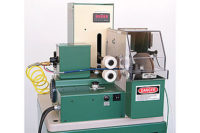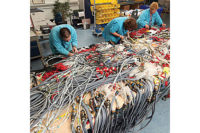When designing a new stove, refrigerator or other appliance, engineers focus mainly on functionality, features, styling and cost. What they don’t always think about is the wiring.
“Usually, the wiring for a stove, furnace or other appliance is forgotten until the last minute, and then the engineers try to throw something together quickly,” laments C. Gustavo Farell, owner and founder of Cesar-Scott Inc., a contract manufacturer with operations in El Paso, TX, and Ciudad Juarez, Mexico. “So we’re always rushing at the end to help with the design effort. They just don’t put much importance on the harness, because they think it’s just wires.”
That sort of attitude is a mistake, says Farell, whose company makes wire harnesses, cable assemblies, electromechanical assemblies, electronic gas igniters and switch harness assemblies. He advises appliance OEMs to get their contractor involved early in the design process.
“We’re not a design group,” says Farell. “However, when it comes to the lay out of the harness or suggestions on materials or routing, we can help.”
Selvin Kao agrees. Kao is the vice president of global services and innovation at Conductive Cable, a manufacturer of wire, cable, power cords and wire harnesses in Rancho Santa Margarita, CA. An 18-year veteran of the wiring business, Kao says his company can provide invaluable advice on material selection and routing of wire harnesses.
“In the appliance industry, cost is everything,” he says. “So when engineers are designing the wire harness, they often want to route the wires in the shortest possible distance, believing that shorter wires will mean less cost.
“However, that’s not necessarily true. You have to think about installation cost and assembly times. One of the biggest problems with wire harnesses is the routing and bunching of the wires. The harness needs to be laid out in such a way that the operator can’t make a mistake during assembly. A wire harness for an appliance could have 30 or 50 terminations, and a lot of them are going to be the same. You want to design the harness so the operator can’t insert a terminal in the wrong spot.”
Kao prefers wire harness designs that look more like a spinal cord than a spider web. The former approach is not only neater, but it’s also easier to install and simpler to service. “The [spinal cord] approach might lead to greater wire lengths overall,” Kao points out. “However, the cost of the wire and the connectors is relatively inexpensive compared with the cost of assembling the harness and installing it.”
Another benefit of consulting with a harness assembler early in the design process is the opportunity to right-size components. “Because engineers typically leave design of the harness to the very end, they tend to use larger gauge wires than they actually need—just to be on the safe side,” says Kao. “You can use 16-gauge wires across the board. It will work. But, a lot of times, it’s overkill.”
Special Materials
The wires, connectors and other materials for appliance harnesses must be designed to accommodate the specific functional and environmental conditions of each device. Voltage, amperage and operating temperature requirements will determine the insulation and gauge of the wire. Extreme vibration, as with a washing machine, will influence the choice of connector and how the harness will be mounted.
“You may also need to consider chemicals, such as detergents and greases, waterproofness, and safety concerns, such as flammability,” says Rick Johnson, owner of RARE Computers LLC in Detroit and a former senior program manager with wire harness maker Yazaki North America. “Assuming you are targeting the U.S. market, all household appliance wiring must meet UL specifications. These specs are dramatically different from the [Society of Automotive Engineers] specs for the auto industry. Europe and Asia also have their own specifications. There is no one-size-fits-all guideline.”
Wiring for refrigerators is almost exclusively UL-rated, unplated stranded wire with PVC insulation, says Douglas DeLashmutt, principal manufacturing engineer at DRS Consolidated Controls in Danbury, CT.
“This type of wire would also be used in dishwashers and ranges where high temperatures would not be present,” he says. “If high temperatures are present, the insulation would likely be a fiberglass material.
“Connectors are typically low-cost plastic and mate with stamped terminals. To gain volume pricing benefits, connector types and sizes will be leveraged across product lines.”
Gas stoves typically use wire with heat-resistant insulation materials, such as cross-linked polyethylene, silicon and Teflon. PVC insulation is adequate for gas furnaces, since the wiring isn’t near the flame.
Quality Control
Because OEMs like to offer consumers variants and options, assembling harnesses for appliances tends to be a high-mix proposition. For example, a furnace manufacturer might offer a family of products that requires 15 different harnesses, says Farell. The harnesses might be identical—the same wires, the same colors, the same terminals—only one harness might be a couple of inches longer than another. Having controls in place to deal with such variety is critical.
“We identify the wires from the moment that we cut, strip and terminate them,” says Farell. “We label the bundles, and we make sure the areas where the wires are placed are clearly identified by part number, so there’s no possibility of mix-ups.
“Also, we try to minimize work in process as much as possible, and we try to make-to-order as best we can.”
Visual workplace techniques are helpful. At Cesar-Scott, engineering drawings are color-coded to match the color of the wire. As much as possible, drawings are made to reflect the actual size of the part, so operators can clearly see differences in lengths and gauges. Reference documents and illustrations showing standard operating procedures are posted above workstations.
Like most harness shops, Cesar-Scott assembles harnesses on pin boards, and each harness must pass functionality, hi-pot and other customer-specific testing. “We release the boards to production just like we would any other tool,” says Farell. “We make sure there’s a first-piece approval, and we typically have a ‘golden sample’ that we’ll bring out and put on the board to make sure that everything marries up and functions correctly.”
Crimp quality is becoming increasingly important to appliance OEMs, says Conductive Cable’s Kao. “We track every crimp with crimp-force monitoring,” he says. “In the past, crimps were tested once per hour. You picked out a terminated wire and did a pull test on it. That’s not good enough. In an hour, you could be producing thousands of bad crimps.”
Crimping presses are configured so that if a bad crimp is detected, the machines either destroy the part or lock up, preventing the defective part from entering production. In addition, Conductive Cable routinely takes cross-sections of crimped connections to ensure that press dies have been set up correctly.
ASSEMBLY ONLINE
For more information on appliance assembly, visit www.assemblymag.com to read these articles:








